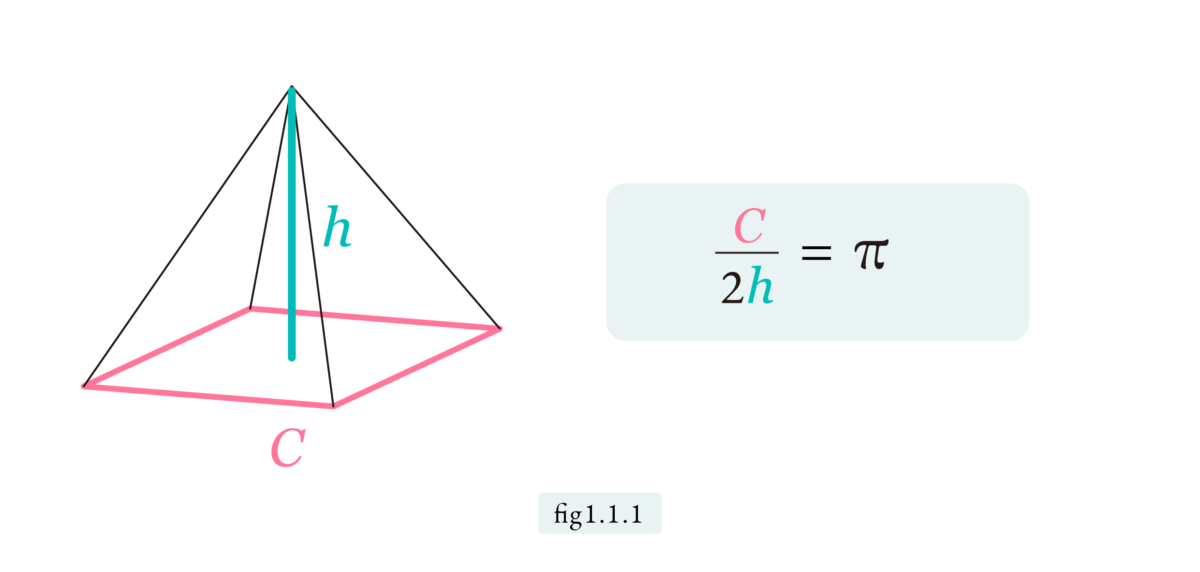Three Mysteries about the Pyramids
Have you heard about the “Mystery of the Pyramids”?
Since ancient times, Egypt has been visited by many people. History and archaeology are popular, and the pyramids are often featured on television. Particularly famous is the Pyramid of King Khufu in Giza, and the term “Great Pyramid” refers to this pyramid.
A Monument of Wonder and Intrigue
Since time immemorial, many people have visited the Great Pyramid and have been overwhelmed by its enormous size. The Great Pyramid was built about 4,500 years ago, and for almost 3,000 years afterward, its surface was covered with a pure white limestone veneer that kept it glistening white. The ancient people who saw this gigantic structure must have been shocked and impressed by its grandeur.
A Mathematical Mystery Worth Exploring
Who could have built such a beautiful, gigantic structure? It is hard to believe that this is the work of human beings. There must be some great treasure, ancient wisdom, or written word of God in it. Of course, opinions varied from period to period and from person to person, with some saying, “Why would someone build such a huge, useless object for a single pharaoh?”
The Great Pyramid is said to be one of the Seven Wonders of the World, and many people have been talking about the “Mystery of the Pyramids” for centuries. Here we will focus on one of these mysteries that is related to mathematics.
First mystery: Does the pyramid contain ‘π’? 』
The Mystery of π
One of the most intriguing claims about the Great Pyramid is its relationship with the mathematical constant π. According to this theory, dividing the circumference of the pyramid’s base by twice its height gives a value very close to π.
What Is π, and Did the Egyptians Know It?
π is defined as the ratio of a circle’s circumference to its diameter:
π = 3.141592654… (1)
This raises a compelling question: did the ancient Egyptians know about π? Or is this resemblance purely coincidental?
The Formula Behind the Mystery
As shown in fig1.1.1, if C is the circumference of the base and h is the height of the pyramid, the formula can be written as:
C / 2h = π

Is the Riddle of Pi Really Reflected in the Great Pyramid?
Let’s see if the Great Pyramid actually fulfills the riddle of pi. You might think that since the Great Pyramid was built 4,500 years ago, it is much weathered and its exact value is not known. Its base appears to have been buried in sand for centuries, helping preserve its original shape. Once adorned with decorative stones, the pyramid’s top and sides are now exposed, revealing massive stone blocks beneath. From the angle of inclination, its height can still be estimated with reasonable accuracy. Various sources present slightly different values, but the following figures are generally regarded as reliable. Minor discrepancies in measurements have little impact on the overall result.
One side of the base square: 230.37 m
Height: 146.6 m (2)
Testing the π Ratio with Real Measurements
Using this value, let’s calculate whether the riddle of pi is valid. Divide the perimeter of the square by twice its height:
230.37 × 4 / 146.6 × 2 = 3.142837653 (3)
Compare with π = 3.141592654 (from equation 1). The results are surprisingly consistent. However, no matter how many coincidences there are, “coincidences” are quite common.
Was It Intentional or Just a Coincidence?
How do historical experts (archaeologists and mathematical historians) view this “coincidence”? Most experts seem to think that the appearance of pi is a coincidence. There are two theories: one is that it was a complete coincidence, and the other is that pi somehow got mixed in without the Egyptians being aware of it. A typical example of “some cause” is “the use of a wheelbarrow, as shown in Figure 1.1.2, to measure length.”

Was Pi Included Accidentally Through Measurement Methods?
To measure a long distance, such as the base of a pyramid, it is easier to use a unicycle than to measure with a rope, and measuring in this way will include π in the measurement. For example, one revolution of a wheel with a radius of 1 meter gives the distance traveled by the wheel as 2π meters. Although it seems like a very compelling theory, this theory has its drawbacks. For one thing, wheels did not come into use in Egypt until later than this, and no evidence of their use for measurement has been found to date. Furthermore, if wheels were used, we do not know why they were used to measure circumference and not height.
Why Did the Egyptians Design It That Way?
The more essential question is: “Why did the Egyptians make the pyramids that way?” In this article, I will only introduce the mystery of pi, and throughout this web series, I would like to state the answer to this question. Specifically, I intend to argue that “the Egyptians designed the pyramids so that their circumference is the circumference of a circle whose radius is their height.”
Did the Ancient Egyptians Know Pi?
There is a reason why it has been believed that “the ancient Egyptians could not have known the ratio of circumference to diameter.” First of all, it was Greek mathematics that proved that the ratio of “circumference to diameter” is constant regardless of the circle—2,000 years after the time of the Great Pyramid. In other words, we recognize that it was not until the Greek period that we got the concept of pi mathematically.
Furthermore, the approximation of π ≈ 22/7 was obtained by Archimedes※, a great Greek mathematician who shines brilliantly in the history of mathematics. Everyone thought that pi ≈ 22/7 could not have been obtained by ancient Egyptian mathematics. However, in the 21st century, it has become clear that mathematics in the Orient (Egyptian and Babylonian mathematics) was surprisingly advanced.
The second mystery: Is the “Golden Ratio” hidden in the pyramids?
Introduction to the Mystery of the Golden Ratio
Next, let us discuss the mystery of the golden ratio. First, consider the following number φ:
φ = 1.618033989 … (4)
This φ is called the golden ratio, and the ratio 1 : φ is known as the golden ratio. What is a ratio, what kind of ratio is the golden ratio, and how the golden ratio is defined as a number will be explained in Chapter 4. For now, think of the golden ratio simply as the ratio 1 : 1.618033989…
Statement of the Mystery
The mystery of the golden ratio can be stated as follows:
The ratio of the side area to the base area of the Great Pyramid is the golden ratio.
Let S₁ be the base area and S₂ be the side area. The mystery of the golden ratio means that:
S₂ / S₁ = φ = 1.618033989…
Geometric Setup of the Great Pyramid
Let h be the height of the pyramid, 2a be the length of one side of the square base, and d be the length of the line from the apex perpendicular to the base (see fig. 1.1.3). The pyramid, when cut in half through its vertical axis, forms an isosceles triangle with base 2a and height h.

The Great Pyramid as a Triangle: Base and Side Area
If the pyramid is cut in two as shown in the figure, the cut plane is an isosceles triangle with base 2a and height h.
- Base area: S₁ = (2a)²
- Lateral area: S₂ = 2ad × 2 = 4ad
Applying the Pythagorean Theorem
Let us see if the mystery of the golden ratio holds true for the Great Pyramid. The length of the slant edge d is calculated using the Pythagorean theorem:
d = √(a² + h²)
Given:
- One side of the base: 2a = 230.37 m → a = 115.185 m
- Height: h = 146.6 m
Calculation:
d = √(115.185² + 146.6²) = 186.4380439 m
Calculating the Ratio S₂ / S₁
S₂ / S₁ = (4ad) / (4a²) = d / a = 186.4380439 / 115.185 = 1.618596553 (5)
Interpretation: Coincidence or Design?
Compare this with the golden ratio φ ≈ 1.618033989 (from equation 4).
The values are almost identical. In other words, the mystery of the golden ratio appears to hold.
However, this could also be a coincidence—just like the π riddle. Since φ is an irrational number, it is unlikely the Egyptians knew it mathematically.
If it’s not a coincidence, then what could be the reason?
Third Mystery: Do the Pyramids Hide the Earth’s Latitude?
The Great Pyramid and Earth’s Measurements
When the Great Pyramid is measured, various numerical values appear. These numbers are considered “astronomical mysteries,” meaning that astronomical values are hidden within them. This article focuses on the idea that the base of the Great Pyramid represents the size of the Earth.
Earth’s Latitude and the Pyramid’s Base
To be precise, one side of the base of the Great Pyramid multiplied by 480 gives the length of one degree of Earth’s latitude.
- Circumference of Earth: ~40,000 km
- One side of the pyramid: 2a = 230.37 m → 230.37 × 480 × 360 = 39,807.936 m ≈ 39,808 km
This is very close to the actual value of Earth’s circumference. But this leads to more questions:
- Why multiply by 480?
- Did the Egyptians use 360 degrees in a circle?
- And why does this align with meters, a modern unit based on Earth’s circumference?
We’ll return to this puzzle in CHAPTER 5.
Ancient Maps and Cartographic Legends
Ancient Greek-era maps of the Mediterranean have survived, showing latitude and longitude. This may relate to the pyramid’s dimensions aligning with Earth’s geometry.
There is even a legend:
“The Great Pyramid was built to immortalize the standard of measure.”
This suggests the pyramid may have been used as a geographic reference point—another topic for CHAPTER 5.
The Engineering Mystery
Aside from mathematical mysteries, there’s also the civil engineering enigma:
How could the ancient Egyptians build something so immense?
Modern historians largely agree that it was within their capability. But when it comes to π or the golden ratio, most do not believe the Egyptians had precise knowledge of these values or intentionally incorporated them.
Alternative Theories: Revelation, Lost Civilizations, or Aliens?
If the values aren’t a coincidence, what could explain them? Three often-cited theories are:
- Divine Revelation – Wisdom passed from gods (once the most accepted view).
- Super-Ancient Civilizations – A highly advanced society that existed over 10,000 years ago.
- Extraterrestrial Influence – Teachings from aliens (more recent and popular in modern pseudoscience).
What Scholars Actually Believe
Historians and archaeologists generally do not support these speculative theories.
Regarding π, most experts think its appearance in the pyramid’s dimensions is:
- A pure coincidence, or
- The result of unconscious approximation during construction.
Numerical patterns can arise by chance. But if a logical explanation exists, especially if the pattern appears in multiple places, that view gains traction.
Rethinking the Pyramid Mysteries
This series offers an alternative perspective to the “coincidence theory.” Given the overwhelming number of such alignments, is it really all by chance?
Let’s explore together the mystery of the pyramids—and whether these patterns hold deeper meaning.

